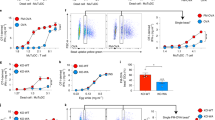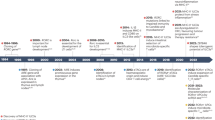Abstract
Dendritic cells constitutively sample the tissue microenvironment and phagocytose both microbial and host apoptotic cells1,2,3,4. This leads to the induction of immunity against invading pathogens or tolerance to peripheral self antigens, respectively5,6,7,8,9. The outcome of antigen presentation by dendritic cells depends on their activation status, such that Toll-like receptor (TLR)-induced dendritic cell activation makes them immunogenic, whereas steady-state presentation of self antigens leads to tolerance5,6,8,10. TLR-inducible expression of co-stimulatory signals is one of the mechanisms of self/non-self discrimination5,11. However, it is unclear whether or how the inducible expression of co-stimulatory signals would distinguish between self antigens and microbial antigens when both are encountered by dendritic cells during infection6,8. Here we describe a new mechanism of antigen selection in dendritic cells for presentation by major histocompatibility complex class II molecules (MHC II) that is based on the origin of the antigen. We show that the efficiency of presenting antigens from phagocytosed cargo is dependent on the presence of TLR ligands within the cargo. Furthermore, we show that the generation of peptide–MHC class II complexes is controlled by TLRs in a strictly phagosome-autonomous manner.
This is a preview of subscription content, access via your institution
Access options
Subscribe to this journal
Receive 51 print issues and online access
$199.00 per year
only $3.90 per issue
Buy this article
- Purchase on Springer Link
- Instant access to full article PDF
Prices may be subject to local taxes which are calculated during checkout




Similar content being viewed by others
References
Greenberg, S. & Grinstein, S. Phagocytosis and innate immunity. Curr. Opin. Immunol. 14, 136–145 (2002)
Ravichandran, K. S. “Recruitment signals” from apoptotic cells: invitation to a quiet meal. Cell 113, 817–820 (2003)
Savill, J., Dransfield, I., Gregory, C. & Haslett, C. A blast from the past: clearance of apoptotic cells regulates immune responses. Nature Rev. Immunol. 2, 965–975 (2002)
Henson, P. M., Bratton, D. L. & Fadok, V. A. Apoptotic cell removal. Curr. Biol. 11, R795–R805 (2001)
Iwasaki, A. & Medzhitov, R. Toll-like receptor control of the adaptive immune responses. Nature Immunol. 5, 987–995 (2004)
Steinman, R. M., Hawiger, D. & Nussenzweig, M. C. Tolerogenic dendritic cells. Annu. Rev. Immunol. 21, 685–711 (2003)
Larsson, M., Fonteneau, J. F. & Bhardwaj, N. Dendritic cells resurrect antigens from dead cells. Trends Immunol. 22, 141–148 (2001)
Steinman, R. M., Turley, S., Mellman, I. & Inaba, K. The induction of tolerance by dendritic cells that have captured apoptotic cells. J. Exp. Med. 191, 411–416 (2000)
Henson, P. M., Bratton, D. L. & Fadok, V. A. The phosphatidylserine receptor: a crucial molecular switch? Nature Rev. Mol. Cell Biol. 2, 627–633 (2001)
Trombetta, E. S. & Mellman, I. Cell biology of antigen processing in vitro and in vivo. Annu. Rev. Immunol. 23, 975–1028 (2005)
Banchereau, J. & Steinman, R. M. Dendritic cells and the control of immunity. Nature 392, 245–252 (1998)
Sauter, B. et al. Consequences of cell death: exposure to necrotic tumor cells, but not primary tissue cells or apoptotic cells, induces the maturation of immunostimulatory dendritic cells. J. Exp. Med. 191, 423–434 (2000)
Gallucci, S., Lolkema, M. & Matzinger, P. Natural adjuvants: endogenous activators of dendritic cells. Nature Med. 5, 1249–1255 (1999)
Turley, S. J. et al. Transport of peptide-MHC class II complexes in developing dendritic cells. Science 288, 522–527 (2000)
Chow, A., Toomre, D., Garrett, W. & Mellman, I. Dendritic cell maturation triggers retrograde MHC class II transport from lysosomes to the plasma membrane. Nature 418, 988–994 (2002)
Thieblemont, N. & Wright, S. D. Transport of bacterial lipopolysaccharide to the Golgi apparatus. J. Exp. Med. 190, 523–534 (1999)
Latz, E. et al. Lipopolysaccharide rapidly traffics to and from the Golgi apparatus with the Toll-like receptor 4-MD-2–CD14 complex in a process that is distinct from the initiation of signal transduction. J. Biol. Chem. 277, 47834–47843 (2002)
Barnden, M. J., Allison, J., Heath, W. R. & Carbone, F. R. Defective TCR expression in transgenic mice constructed using cDNA-based α- and β-chain genes under the control of heterologous regulatory elements. Immunol. Cell Biol. 76, 34–40 (1998)
Viret, C. & Janeway, C. A., Jr . Functional and phenotypic evidence for presentation of Eα52–68 structurally related self-peptide(s) in I-Eα-deficient mice. J. Immunol. 164, 4627–4634 (2000)
Rudensky, A., Rath, S., Preston-Hurlburt, P., Murphy, D. B. & Janeway, C. A., Jr . On the complexity of self. Nature 353, 660–662 (1991)
Watts, C. The exogenous pathway for antigen presentation on major histocompatibility complex class II and CD1 molecules. Nature Immunol. 5, 685–692 (2004)
Boes, M., Cuvillier, A. & Ploegh, H. Membrane specializations and endosome maturation in dendritic cells and B cells. Trends Cell Biol. 14, 175–183 (2004)
Zhong, G., Reis e Sousa, C. & Germain, R. N. Production, specificity, and functionality of monoclonal antibodies to specific peptide-major histocompatibility complex class II complexes formed by processing of exogenous protein. Proc. Natl Acad. Sci. USA 94, 13856–13861 (1997)
Luhrmann, A. & Haas, A. A method to purify bacteria-containing phagosomes from infected macrophages. Methods Cell Sci. 22, 329–341 (2000)
Storrie, B. & Madden, E. A. Isolation of subcellular organelles. Methods Enzymol. 182, 203–225 (1990)
Cresswell, P. Invariant chain structure and MHC class II function. Cell 84, 505–507 (1996)
Denzin, L. K. & Cresswell, P. HLA-DM induces CLIP dissociation from MHC class II αβ dimers and facilitates peptide loading. Cell 82, 155–165 (1995)
Blander, J. M. & Medzhitov, R. Regulation of phagosome maturation by signals from Toll-like receptors. Science 304, 1014–1018 (2004)
West, M. A. et al. Enhanced dendritic cell antigen capture via Toll-like receptor-induced actin remodeling. Science 305, 1153–1157 (2004)
Mathis, D. J., Benoist, C., Williams, V. E. II, Kanter, M. & McDevitt, H. O. Several mechanisms can account for defective E α gene expression in different mouse haplotypes. Proc. Natl Acad. Sci. USA 80, 273–277 (1983)
Acknowledgements
We are grateful to I. Mellman, M. Bevan, J. Monaco and R. Germain for reagents, and E. Kopp for the flagellin–OVA fusion construct. We thank P. Cresswell and A. Rudensky for reagents, suggestions and critical reading of the manuscript. We are indebted to I. Mellman, E.S. Trombetta, L. Delamarre and J. Kagan for discussions; M. Pypaert and C. Marks for electron microscopy; C. Chalouni and R. Montgomery for confocal microscopy; A. Hartley for 3D reconstructions; D. Amsen, A. Giodini, R. Teal, T. Horng, T. Potseleuva, C. Annicelli, S. Holley, R. Couture, D. Matosian, T. Taylor, G. Tokmoulina, J. Shanabrough, M. Blander and S.J. Blander for assistance and support. J.M.B. is supported by an Arthritis Investigator award. R.M. is supported by the Howard Hughes Medical Institute and the NIH.
Author information
Authors and Affiliations
Corresponding author
Ethics declarations
Competing interests
Reprints and permissions information is available at npg.nature.com/reprintsandpermissions. The authors declare no competing financial interests.
Supplementary information
Supplementary Methods
This file contains additional details of the methods used in this study. (PDF 129 kb)
Supplementary Method Figure 1
The phagosomal pellet F10 consists of intact phagosomes that contain LAMP-2 and Rab-7. Following ultracentrifugation, an aliquot of the pellet F10 was diluted in RPMI medium and centrifuged onto alcian blue treated glass coverslips at 4000 rpm for 15 min. Phagosomes were fixed onto coverslips with 4% paraformaldehyde, quenched in glycine and stained. (PDF 609 kb)
Supplementary Figures
This file contains Supplementary Figures 1–14. (PDF 7770 kb)
Supplementary Movie 1.
A confocal three dimensional reconstructed image from Fig. 4e (top panels) is shown rotating at different angles. CD11c+ DC at 5 h post phagocytosis of both 4.5 µm HEL and 10 µm HEL/LPS conjugated microspheres. The C4H3 epitope (red) was detected around the phagosome containing the 10 µm microsphere by intracellular staining. I-Ak is shown in green and surface CTB in blue. (MOV 3761 kb)
Supplementary Movie 2.
A confocal three dimensional reconstructed image from Fig. 4e (bottom panels) shown rotating at different angles. CD11c+ DC at 5 h post phagocytosis of both 4.5 µm HEL/LPS and 10 µm HEL conjugated microspheres. Intracellular C4H3 epitope (red) was detected staining the phagosome containing the 4.5 µm microsphere. I-Ak is shown in green and surface CTB in blue. (MOV 1857 kb)
Rights and permissions
About this article
Cite this article
Blander, J., Medzhitov, R. Toll-dependent selection of microbial antigens for presentation by dendritic cells. Nature 440, 808–812 (2006). https://doi.org/10.1038/nature04596
Received:
Accepted:
Published:
Issue Date:
DOI: https://doi.org/10.1038/nature04596
This article is cited by
-
MHCII expression on gut macrophages supports T cell homeostasis and is regulated by microbiota and ontogeny
Scientific Reports (2023)
-
Gasdermin D restricts Burkholderia cenocepacia infection in vitro and in vivo
Scientific Reports (2021)
-
TAP dysfunction in dendritic cells enables noncanonical cross-presentation for T cell priming
Nature Immunology (2021)
-
PLGA-particle vaccine carrying TLR3/RIG-I ligand Riboxxim synergizes with immune checkpoint blockade for effective anti-cancer immunotherapy
Nature Communications (2021)
-
Ex vivo dendritic cell-based (DC) vaccine pulsed with a low dose of liposomal antigen and CpG-ODN improved PD-1 blockade immunotherapy
Scientific Reports (2021)
Comments
By submitting a comment you agree to abide by our Terms and Community Guidelines. If you find something abusive or that does not comply with our terms or guidelines please flag it as inappropriate.



